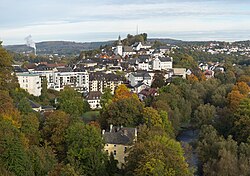Arnsberg
Town in North Rhine-Westphalia, Germany From Wikipedia, the free encyclopedia
Town in North Rhine-Westphalia, Germany From Wikipedia, the free encyclopedia
Arnsberg (German pronunciation: [ˈaʁnsbɛʁk] ; Westphalian: Arensperg) is a town in the Hochsauerland county, in the German state of North Rhine-Westphalia. It is the location of the Regierungsbezirk Arnsberg administration and one of the three local administration offices of the Hochsauerlandkreis district.
This article has multiple issues. Please help improve it or discuss these issues on the talk page. (Learn how and when to remove these messages)
|
Arnsberg | |
|---|---|
 | |
Location of Arnsberg within Hochsauerlandkreis district  | |
| Coordinates: 51°23′N 8°5′E | |
| Country | Germany |
| State | North Rhine-Westphalia |
| Admin. region | Arnsberg |
| District | Hochsauerlandkreis |
| Subdivisions | 15 |
| Government | |
| • Mayor (2018–23) | Ralf Paul Bittner[1] (SPD) |
| Area | |
| • Total | 193.45 km2 (74.69 sq mi) |
| Elevation | 212 m (696 ft) |
| Population (2023-12-31)[2] | |
| • Total | 74,206 |
| • Density | 380/km2 (990/sq mi) |
| Time zone | UTC+01:00 (CET) |
| • Summer (DST) | UTC+02:00 (CEST) |
| Postal codes | 59755, 59757, 59759, 59821, 59823 |
| Dialling codes | 02931 Arnsberg 02932 Neheim-Hüsten 02935 Wennigloh 02937 Oeventrop |
| Vehicle registration | HSK |
| Website | www.arnsberg.de |

Arnsberg is located in the north-east of the Sauerland in the Ruhr river valley. The river Ruhr meanders around the south of the old town of Arnsberg. The town is nearly completely encircled by forest, and the nature park Arnsberger Wald lies to the north".
Arnsberg is connected by Federal Motorway 46 (Autobahn 46) Brilon in the east and (using the Federal Motorway 445) Werl in the west. It is also connected by several railroad stations, which provide a connection to the major city Dortmund and the Ruhrgebiet. There is also a regional airport, located in the city district of Vosswinkel, which is exclusively used for small private aircraft.
The municipal territory spans a distance of up to 13 kilometres (8.1 mi) from the southern to the northern limits.[3]
After the local government reforms of 1975 Arnsberg consists of 15 boroughs (Ortsteile):

Arnsberg was first mentioned in 789 in the Carolingian records (Urbar) as belonging to the abbey of Werden.
Arnsberg was the seat of the Counts of Arnsberg from around 1070 and received city rights in 1238. In 1368 the last of the Counts of Arnsberg, Count Gottfried IV, handed over the city and county to Kurköln as he had no heir.[4]
They built a castle there whose remains can still be visited and are occasionally used for public celebrations.
In the 12th century, old Arnsberg became the seat of Westphalian jurisdiction (whose coat of arms is still used today by the Hochsauerlandkreis). Later, the city lost its independence and was subject to the Archbishops of Cologne.
Arnsberg Castle was reconstructed by Johann Conrad Schlaun as a residential palace and hunting lodge for Elector Clemens August of Bavaria. It was destroyed in the Seven Years' War in 1769.
In 1794 the French attacked Cologne, so parts of the treasure of the Cologne Cathedral were brought to safety in Arnsberg, along with the relics of the Biblical Magi. In 1804, the treasure was returned to Cologne, as commemorated by a plaque in the Propsteikirche.
In 1816, Arnsberg came under Prussian rule and was made a local administrative centre.
Neheim and Hüsten were merged in 1941.
During the Second World War, Arnsberg first suffered widespread destruction and catastrophic loss of lives when RAF Lancasters breached the dam of the Möhne Reservoir in the night of the 16 to 17 May 1943 (Operation Chastise). The nearby Abbey Himmelpforten was completely washed away.
Later, dozens of Arnsberg's citizens were killed in several British air raids aimed at destroying the railway viaduct. The targets were finally destroyed on 19 March 1945 using a 'Grand Slam' bomb.[5]
The current city of Arnsberg was created in 1975 by merging 12 surrounding municipalities (Bachum, Breitenbruch, Herdringen, Holzen, Müschede, Niedereimer, Oeventrop, Rumbeck, Uentrop, Voßwinkel and Wennigloh) into one city.[6]
Old Arnsberg itself and Neheim-Hüsten are the two main urban areas, while the other parts are mainly rural areas.
Arnsberg's population is mostly Roman Catholic. Arnsberg belongs to the Archdiocese of Paderborn. Catholic churches include the "Propsteikirche" or the "Heilig-Kreuz Kirche" and the "Auferstehungskirche", which is a Protestant church. There is also a New Apostolic congregation.[citation needed]
In recent years Arnsberg's Muslim minority grew considerably.[citation needed] The town has a mosque.
The cemeteries are mostly Catholic but there is also a Jewish cemetery.
The Kunstverein Arnsberg operates in Arnsberg. Founded in 1987 and devoted to contemporary art, Kunstverein Arnsberg has presented solo exhibitions by artists including Georg Baselitz, Thomas Ruff, Karin Sander, Dan Perjovschi, Boris Mikhailov, Gregor Schneider, Erwin Wurm, the Turner Prize winner Susan Philipsz and the Marcel Duchamp Prize winner Laurent Grasso.
The arms of the city depict a white eagle on a blue field. Earlier it was a white eagle on a red field, introduced in 1278 and as used by the counts of Arnsberg . In the 17th century the red was changed to blue, reflecting the Bavarian blue of the House of Wittelsbach.
Mayors of the new town Arnsberg
This article's list of residents may not follow Wikipedia's verifiability policy. (October 2024) |


Seamless Wikipedia browsing. On steroids.
Every time you click a link to Wikipedia, Wiktionary or Wikiquote in your browser's search results, it will show the modern Wikiwand interface.
Wikiwand extension is a five stars, simple, with minimum permission required to keep your browsing private, safe and transparent.